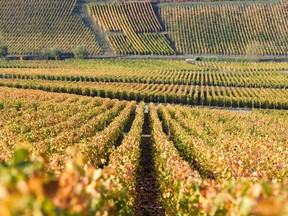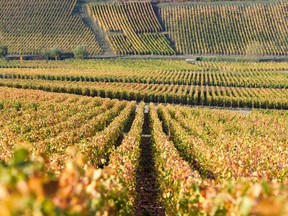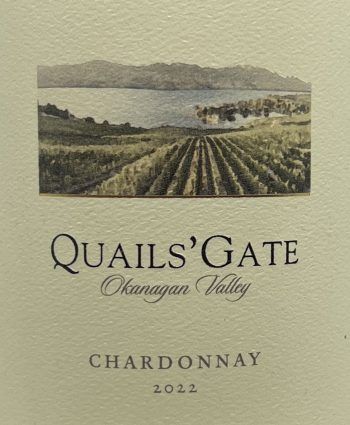Reviews and recommendations are unbiased and products are independently selected. Postmedia may earn an affiliate commission from purchases made through links on this page.
Anthony Gismondi: Making sense of the claim to organic wine production

Production should be guided by little or no manipulation of wines including reverse osmosis, excessive filtration, or flavour additives

Article content
Organic wine production elicits both the best and worst in people, particularly those who perceive the world in absolutes. Introduce the terms wine and sulphites to the discourse, and you ignite an even more considerable debate, as the definition varies depending on the country of origin, grape or wine production, and sometimes its destination. This complexity is not surprising, given the mysteries of wine have been a pursuit of wine marketers for centuries.
Advertisement 2
Article content
In the vineyard, organic wine is made from grapes grown without chemical fertilizers, pesticides, fungicides and herbicides. At the winery, production should be guided by little or no manipulation of wines including reverse osmosis, excessive filtration, or flavour additives, such as liquid tannin and oak chips.
Article content
Add to that the global debate about whether or not sulphites should be used in organic wine production — standards vary worldwide — and you have quite a mess. Another fly in the ointment is the additional and confusing label that says made with organic grapes This category can be used in the U.S. if the grapes used to make the wine are 100 per cent certified organic, but the wine has added sulphites — up to 100 parts per million — or uses non-native yeasts. Europe does not have a comparable label.
Similar issues surround the somewhat more cerebral biodynamic winemaking standards based on the teachings of Austrian anthroposophist Rudolph Steiner (1861-1925), which incorporate homeopathic and astrological considerations into the organic process.
Amid the intricacies, it is evident from my extensive experience interviewing winemakers and grape growers and exploring vineyards worldwide that a profound realization is dawning. Most everyone involved increasingly recognizes the Earth as a precious, finite resource, and their daily actions have far-reaching implications for their health, the health of their employees and families, and the health of their customers. This growing awareness is inspiring more and more producers to view themselves as custodians of the land, shaping their conduct and businesses accordingly.
Advertisement 3
Article content
Are there still cheaters? Yes. Do some organic producers pass off poor wine to unsuspecting consumers? You bet. But that happens in all facets of life. Natural, green, Earth-friendly, fish-friendly, organic, and biodynamic wines are words, not deeds. The bigger picture is that most of the wine businesses at the grassroots level are taking the lead in instituting all measures of environmentally responsible agriculture and wine production.
In places like Chile, California, and New Zealand, the wine industry has launched comprehensive programs to change the culture of wine growing from the ground up, including trying to effect cultural change among its employees. In South Africa, wine producers are also at the forefront of removing non-indigenous vegetation and letting the surrounding land return to its normal state.
In B.C., the current deep freeze damage aside, grape growing methods are undergoing a sea change, with hundreds of hectares going organic since 2020. Some think that half our vineyard sites will be farmed organically by 2030. That would make B.C. home to the largest percentage of organic vineyards planted worldwide by hectares.
Article content
Advertisement 4
Article content
Not all organic programs are certified by a government agency. However, like many of Europe’s producers who work organically and do not seek certification, caring for their piece of dirt to the best of their ability may be the most critical result. The good news for wine buyers is that the field of wines made with organically grown grapes is expanding quickly, which means more choice.
There has been some positive movement to make these wines easier to find in retail stores, but few retailers have prioritized this. The search tab marked “organic” in the drop-down menu on the B.C. liquor website yielded 97 wines. All our weekend wine picks today are certified organic.
Weekend wine picks

Umani Ronchi CaSal di Serra Verdicchio dei Castelli di Jesi Classico Superiore 2020, Marche, Italy
$19.99 I 89/100
UPC: 8032853721124
The engine of this wine is an organically grown Verdicchio, and vines up to 30 years old sitting on calcareous, clay, loamy hillsides on the Adriatic Coast. The fruit shines, mixing citrus, pear, and toasted almonds, all supported by a stony fresh mineral undercurrent with a surprising amount of weight. Any spring dish or any shellfish selection, raw or cooked, on the West Coast will work here. Fine value.
Advertisement 5
Article content

Tormaresca Trentangeli Castel del Monte Aglianico – Cabernet Sauvignon – Syrah 2018, Puglia, Italy
$19.99 I 91/100
UPC: 8026530000862
Trentangeli is a 65/25/10 mix of Aglianico/Cabernet Sauvignon/Syrah and it is all Apulia. The nose is a fragrant mix of violets and intensely savoury dark fruit with a dusting of smoke and spice. It is a beautiful mix of power and freshness, pitching black raspberry, licorice and balsamic notes that finish with persistence and surprising suppleness. Think big dinner dishes: lamb osso buco, rice with Bolognese sauce or mature cheeses. It is also certified organic and one of the biggest red wine bargains in the province.

Faustino Rioja Organic 2020, Rioja, Spain
$19.99 I 87/100
UPC: 8410441112002
This is a new wine from an old Rioja wine producer that is surprisingly certified organic. The colour is dark, the yields are low, and the tempranillo mixes black and red berries. The attack is round but fresh, and the tannins are youthful but light. It is a perfect mid-week chicken wine that would also suit soft cheese.

Robin Ridge Organic Gamay 2021, Keremeos, Similkameen Valley, B.C.
Advertisement 6
Article content
$23.99 I 90/100
UPC: 626990155027
Gamay continues to shine at Robin Ridge, a tiny boutique producer in the wild, windy, rocky Similkameen. The terroir is spare, providing the perfect platform for this Gamay to thrive. Lean, tight, and red-fruited, with cherry and black plum nuances, this is vibrant from front to back. Precision and delicacy with a peppery undercurrent draw it across your palate in a straight line, asking for a chunk of grilled salmon or pork sausages. Crunchy, juicy, and mineral-scented, it has all the attributes of seriousness. Now available in B.C. liquor stores.

Rocca di Montegrossi Chianti Classico Organic 2021, Tuscany, Italy
$35.99 I 92/100
UPC: 8032956630040
This wine has a beautiful depth, a testament to the vintage and the rising star of Chianti Classico. Harmonious and long, it is simply impressive for the money. Mushroom pasta continues to be a brilliant match. Wonderful value. Experts have recognized the 2021s as among the best made in the region.
There is a new restaurant in West Kelowna: 31 Charkay is at 2550 Boucherie Rd., next to Grizzli Winery. The name honours the address of an extraordinary woman who influenced partner Amy Chang. Grandma Helen “was a woman ahead of her time, fiercely independent and hardworking,” who taught Amy “to choose love repeatedly, and love,” says Chang, “is at the heart of everything they do at 31 Charkay.”
Advertisement 7
Article content
Chef Tye Mclellan and Chang offer a rich lineup of foods that honours the various cultures that make up Canada and the people who have inspired us along the way. Just some of the menu illustrates its diversity: Mediterranean Bannock to Mushroom and Duck Wontons to Orange Basil Sockeye Salmon, Grilled Sesame Chicken Bowl, Kabocha Squash Ravioli and Chimichurri New York Steak. The restaurant 31 Charkay joins an impressive list of West Kelowna restaurants, including The Restaurant at Mission Hill and Frind Beach Patio Restaurant, Mt. Boucherie’s The Modest Butcher — Kitchen + Market and the Quails Gate Old Vines Restaurant.
•••
There may be some good news on the horizon for olive oil lovers. As the world leader in olive oil production, Spain has witnessed a nearly 10 per cent drop in the value of Extra Virgin Olive Oil since the beginning of April. Current prices have decreased by approximately 17 per cent on average from January. A decrease in local consumption in the face of high prices likely played a role in falling prices, but you can also throw in greed. Cash liquidity challenges for producers and the need to make room for a new crop are equally pushing prices down. Many Spanish co-operatives, producers, and mills that held onto their oil stock in the hopes of further price increases are running out of time to pay farmers for their olives from the 2023 harvest while the value of their inventory is falling fast. Nothing is inevitable, but lower olive oil prices will undoubtedly be welcomed in Canada.
Advertisement 8
Article content
B.C. wine of the week

Quails’ Gate Chardonnay 2022, Okanagan Valley
$26.99 I 89/100
UPC: 778856121018
The classic Quails’ Gate Chardonnay comes from several family-owned sites and is fermented in a mix of vessels from stainless steel tanks to neutral French oak. It goes through partial malolactic fermentation to retain its freshness and spends nine months on its lees while adding some creamy textures to the mix. The attack is a balanced mix of citrus, and creamy bakery notes spiked with fresh pear and barrel spice. The stylish, new, round, and easy-to-drink white is the perfect Chardonnay to serve a large crowd at this price point — shellfish, halibut, and roasted chicken all work here.
Value wine of the week

Paul Mas Viognier 2022, Vin de Pays d’Oc, Languedoc, France
$16.99 I 88/100
UPC: 3760040420127
Consistently fun to drink and never overprocessed, the Paul Mas Viognier is a wine that will appeal to the masses. Fragrant, floral aromas spill onto the palate, along with citrus, ginger, and pineapple. Fresh and lively, it is a go-to white for chicken or pork and an all-season wine. The Mas recipe mixes Viognier from cool and warm sites using young and old vines and relatively low yields at 52 hl/ha. Back up the truck again.
Bookmark our website and support our journalism: Don’t miss the news you need to know — add VancouverSun.com and TheProvince.com to your bookmarks and sign up for our newsletters here.
You can also support our journalism by becoming a digital subscriber: For just $14 a month, you can get unlimited access to The Vancouver Sun, The Province, National Post and 13 other Canadian news sites. Support us by subscribing today: The Vancouver Sun | The Province.
Article content
Source: vancouversun.com

